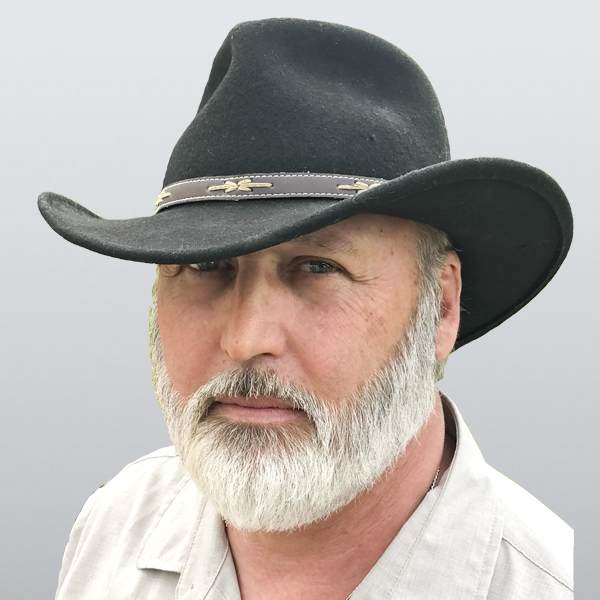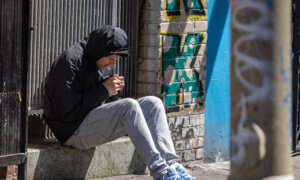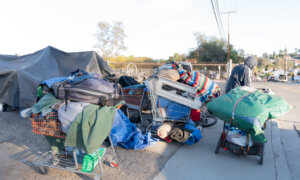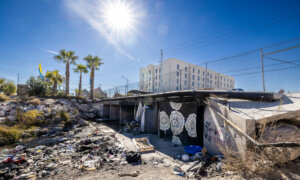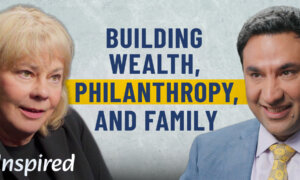SAN FRANCISCO—A naked man wearing a red baseball cap jogs past drug users and homeless people on Jones Street, between Turk and Eddy, in the city’s Tenderloin district, while an unsuspecting woman on the street shrieks at him.
Nearby, a young man—possibly high on fentanyl, tranq, or both—is on his hands and knees in the middle of the sidewalk, oblivious to people casually walking around him. He can barely move, as if frozen. About half an hour later, he is still in the same position.
On another block, several men sitting against a wall in a back alley try to hide their needles when they notice a photojournalist’s camera.
The smell of urine and body odors is broken only by wafts of marijuana smoke.
Chatter is steady but subdued, with occasional outbursts. Some individuals mutter or shout at beings that exist only in their hallucinations.
In the Tenderloin, drug-induced psychosis is common.
Local activist JJ Smith walks through the district almost every day, encouraging drug users to seek medical attention for infected sores or treatment for addiction. By all accounts, he’s a good Samaritan who offers to help people by taking them to a hospital or driving or walking them to a detox or rehab facility.
Smith has been doing this ever since his brother, Rodney, died alone from a fentanyl overdose in a single-room occupancy (SRO) hotel. About a year ago, he saw his brother buy the drug on the street and enter an SRO with a harm reduction kit, where he later overdosed.
The grief gets to him, and so he spends his time trying to help drug users when they’re ready to kick their addictions.
Smith knows hundreds of homeless and drug-addicted people in the Tenderloin, which spans about 50 city blocks between Union Square and the Civic Center.
He has gained the trust of people on the street by showing them respect no matter their condition.
“By giving them that respect, they give me respect. They’re here in the streets and they know I’m from the streets, and I’m not judgmental,” he said. “I build relationships with them.”
Respect comes easily, he said, when you stop to realize that a homeless drug addict on the street is somebody’s husband, wife, brother, sister, son, or daughter.
“They weren’t always users. They had jobs, and most still have families who love them, want them to get help, get clean, and come home,” Smith said. “They were someone. They were firemen, attorneys, and they were construction workers. I even had one who was a senator’s son.”

JJ Smith checks on the well-being of homeless drug addicts in the Tenderloin District of San Francisco on May 16, 2024. (John Fredricks/The Epoch Times)
Infections, Amputations
When Smith sees anyone with open sores and infection, he coaxes the person to get treatment and offers to call street rescue teams for help.Some of the addicts are in wheelchairs because they’ve lost infected limbs to sepsis.
Smith has before-and-after photographs of a woman with infected sores on her feet. He begged her to go to the hospital, even reassuring her that she could return to the street once her wounds were treated, but she refused. A few months later, he saw her on the street—this time in a wheelchair—with both legs amputated below the knee.
Infections are more prevalent with more tranq on the streets, Smith said.
Tranq, or xylazine, is an animal tranquilizer often combined with fentanyl. Users inject, snort, swallow, or inhale the drug, which makes them drowsy, slowing down breathing, heart rate, and blood pressure to dangerously low levels, according to the National Institute on Drug Abuse.
It can be lethal, especially when used with fentanyl, alcohol, or benzodiazepines, and is known to cause open sores that often lead to rotting skin and muscle tissue and limb amputations.

A homeless person in the Tenderloin District of San Francisco, on May 16, 2024. (John Fredricks/The Epoch Times)
What is Homeless?
As of Jan. 30, 2024, there were more than 8,300 homeless people in San Francisco, a 7 percent increase since the 2022 point-in-time count, according to the city’s Department of Homelessness and Supportive Housing.Smith tells the story of a fentanyl addict whose father died and left him a home, yet the man is still considered homeless by the San Francisco Homeless Coalition.
While walking up the street from the Eddy Hotel, Smith sees his cousin, who is hooked on meth, leaning against a wall with a blanket wrapped around her legs. He stops to chat and casually reminds her that she doesn’t have to live on the streets and that her family wants her to come home.
“The Homeless Coalition would describe her as homeless,” he said. “I would differ. I would say that’s not so because she has a home. She has a husband that brings her food, brings her money and everything.”
As far as Smith knows, his cousin has no problems at home—other than her drug addiction—but, even if she did, she could live with her daughter in the city, he said.
“Her daughter has open arms to let her come home with her, but she chooses to be here due to the drugs,” he said. “So I don’t understand. How could you categorize someone that has a place as homeless?”
Public Safety
At another street corner, Smith points to a bullet hole in a building across the street from the University of California College of the Law. The window on the school door was shot out, and a stray bullet ricocheted across the street, breaking another window at a business, he said.“Now, imagine if it was this time of the day when people were walking around here and all the businesses were open,” he said. “Anybody could have been shot.”
Smith tries to make the streets safer for children by keeping drug users and dealers away from school and park entrances, even though he was once attacked by dealers, one wielding a machete, which left him with a deep gash in his head.
As schoolchildren make their way down the street, Smith ushers them around a man lying on the sidewalk. With his feet bleeding through bandages from infected wounds, the man is lethargic and appears to be in agony as he picks at the open sores.

JJ Smith checks on the well-being of homeless people in the Tenderloin District of San Francisco on May 16, 2024. (John Fredricks/The Epoch Times)
When the children have safely passed, Smith attempts to talk to him, but the man is incoherent. Smith calls for help. When a street rescue crew arrives, two of them assist the man, while another scolds journalists for photographing the scene on the public street.
Smith, a citizen journalist who has developed a social media presence on X and other social media platforms to share video footagege of the bleak conditions on the streets, said he strongly believes in free speech as a means to expose human suffering. He said that keeping the raw reality of the drug crisis out of sight and out of mind from the American people isn’t working to effect change.
Steve Adami, executive director of “The Way Out,” The Salvation Army’s homeless initiative with a focus on recovery in San Francisco, said he admires Smith for his efforts.
“JJ Smith’s street journalism in San Francisco’s Tenderloin has shown the harsh realities of addiction and homelessness,“ Adami told The Epoch Times. ”His work has made a tangible impact, encouraging reform and amplifying the voices of the city’s most vulnerable.”

A man sits in the Tenderloin District of San Francisco, Calif., on May 16, 2024. (John Fredricks/The Epoch Times)
Connecting Families
A block or two later, Smith meets another man, who tells him that his wife is worried about him and wants him to call home.“He’s been missing for two years,” Smith said.
Smith gets calls from many people, including some from out of state asking him to check in on their drug-addicted loved ones.
He reads a message he received from the man’s wife: “I was thinking he was going to call me on my birthday, but I know how things are out there. Just tell him he hasn’t broken my heart, and I love him dearly. Just tell him just to please reach out to me. I love him no matter what.”
One man, Josh, from a southeastern state, was 19 years old when Smith met him.
“Josh has a family. They call me to check in on him. His father looks for him. He flies out here to see him and try to convince him to come home,” Smith said.
“Josh don’t want to go home.”
“I have Judy,“ he said. ”Her mother comes down here and looks for me, and we go see her.”
Another woman, Lisa, also comes to the Tenderloin to search for her daughter.
“Her daughter has two kids at home, but [she] don’t want to go back home. Her daughter wants to stay on the streets,” Smith said. “Practically everyone I speak to out here has a family and has someone that’s looking for them and want them to come home.”
Many of the addicts he meets are between the ages of 19 and 35. Most are in their 20s, “still kids” in their parents’ eyes, he said.

Local activist JJ Smith calls for medical help in San Francisco’s Tenderloin district, on May 16, 2024. (Brad Jones/The Epoch Times) <strong><br/></strong>
Retail Theft
Some addicts take the public transit system to Oakland, where “they go into stores and steal” and then come back to the Tenderloin to sell the stolen goods for drugs, Smith said.Fentanyl and meth are cheap—about $5 to $10 a hit, he said, so if an addict can sell $75 worth of stolen goods, they’ve got enough cash “to get high all night.”
“Then they go do it again the next day,” he said.
Community churches and nonprofit charities hand out meals to the homeless.
“You have people that come out here and pass out sandwiches,” Smith said.
Overdose Deaths
An estimated 107,543 people died of drug overdoses in the United States in 2023, according to provisional data from the U.S. Centers for Disease Control (CDC). In 2022, 10,952 people died from an overdose in California, which had the fifth-highest drug overdose mortality rate, at 26.9 per 100,000 people.Mothers Against Drug Addiction and Deaths held a candlelight vigil in San Francisco in late August recognizing 1,400 overdose deaths between January and July.
Losing a loved one or anyone he’s met on the street to a drug overdose is always painful, Smith said.
“It hurts,” he said. “It bothers me, but I just keep them in my memory. I just have to keep on movin’ on because there’s somebody else I could probably help out to save from going bad.”

A drug user displays his hit of fentanyl in the Tenderloin District of San Francisco on Feb. 23, 2023. (John Fredricks/The Epoch Times)
A woman Smith knew as a child overdosed and died in an SRO when her boyfriend bought some crack cocaine laced with fentanyl, he said.
“She OD’d in the room,” Smith said. “He left her. They found her about four or five days later.”
Her mother now calls him every week.
“We talk on the phone about her daughter. She’s very distraught that her daughter passed away,” he said.
Early one morning, Smith went to move his car for street cleaning when he found a young man sitting on a curb with his head in his lap. He shouted at the boy to get up and move because the street cleaner was coming, but the man didn’t budge.
“He was right there dead all that time, a young kid. I think he was 19 years old,” Smith said.
When the man’s mother heard that Smith had found her son and had a video of him, she asked him to speak at the funeral.
“This is the first funeral in my life that I ever stood up and spoke to an audience,” Smith said. “I didn’t know her before then, but we built a tight bond and a good friendship. We speak all the time now. She calls me when she has issues.”

A homeless man picks through trash in San Francisco’s Tenderloin District, on May 16, 2024. (Brad Jones/The Epoch Times)
A Helping Hand
Smith often takes addicts who want to get clean to The Salvation Army’s Harbor Light Center. He either walks with them or drives them in his car, but first, he takes them to a clinic to be tested for COVID-19 and tuberculosis.He asks them which drugs they’ve been using and how much to get an idea of how addicted they are and whether they will need medically assisted detox.
“If they say they’re not going to be kicking or they don’t use fentanyl—if they use crack or meth, they’re not going to kick—I can take them straight to the program, and then they’ll handle it from there. But if they say they are, I‘ll take them to another clinic where they can get ... methadone, and then I’ll take them to Harbor Light.”
The Harbor Light Center on Harrison Street has never turned away anyone he’s brought in for detox, Smith said.
Beacon of Hope
Adrian Maldonado, program director at Harbor Light and a recovering heroin addict who has stayed clean for nearly 25 years, has worked with Smith to get people into detox and rehab.The Salvation Army’s Harbor Light alcohol and drug recovery programs are state-licensed to provide medication-assisted detoxification and rehabilitation, which means addicts who are using methadone, suboxone, or naltrexone, are welcome, Maldonado said.
“Doesn’t matter, you can stay. Show up here, and ask to come into detox. We’re going to take you in. We’re going to give you a bed,” he said. “We don’t put up barriers for people. ”
Clients don’t need health insurance, he said, because Harbor Light will “take them into treatment whether there’s a funding source or not.”
The Salvation Army programs are multifaceted and vary across the country, but the Harbor Light Recovery Wellness Center in San Francisco offers the first step toward recovery and is focused on detox, stabilization, and withdrawal management.
The next step is the six-month Harbor Light Residential Drug Treatment Program, an evidence-based model with therapeutic community values that teaches accountability, coping strategies, and lifestyle changes, rather than just abstinence from drug use.
“This model shows that you can teach people how to be clean,“ Maldonado said. ”They can start to then live clean and sober, and be productive, and they don’t need all of the medication-assisted treatment.”
The program helps participants build a strong foundation for lifelong recovery and prepares them for entry into the Joseph McFee Center, a pilot project that provides long-term transitional housing for those leaving residential treatment.
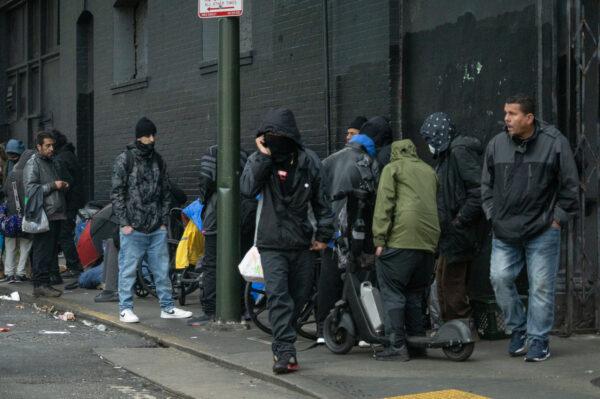
Homeless people stand on the sidewalk among alleged drug dealers in San Francisco, on Feb. 23, 2023. (John Fredricks/The Epoch Times)
‘Why the Pain?’
“Fundamentally, we are a trauma-responsive treatment program, which means we’re looking at trauma as a foundational reason why people are in distress with either substances, their mental illness, and or any other behaviors that cause them harm and cause harm to others,” Maldonado said.The question isn’t “Why the dope?” but “Why the pain?” he said.
“Why are there so many people in such [psychological] and emotional and spiritual distress that the only option that gives them any relief—any sense of safety or connection—is something that they know is so harmful for them?” he said.
“That’s what we’re not addressing. That’s a systemic question. In my view, we live in a society that exacerbates emotional pain and trauma and creates conditions where people don’t feel the connection, support, or community to be able to regulate their emotions appropriately as human beings are designed to do, and then you see them out there trying to manage this internal pain on top of the egregious conditions of being out in the street.”
As a recovering addict, Maldonado knows only too well the hopelessness that addiction fosters, he said.
“It affected my life directly, and the people that love me and that I love, and I certainly could understand JJ’s motivation if somebody that he was close to and loved lost their life because they were using drugs and were not able to find the opportunity to get clean and sober,” he said.
Because the Harbor Light programs are state-licensed, participants in the residential program must spend 20 hours a week minimum in group classes, some of which are clinically based.
The Salvation Army is a well-known Christian-based organization, and although spirituality is an option for anyone in recovery, Harbor Light is not exclusively faith-based, Maldonado said.
“It is not a religious program,” he said.

A homeless woman and her belongings in San Francisco on Feb. 23, 2023. (John Fredricks/The Epoch Times)
Mental Health Services
Harbor Light has counselors available to serve people addicted to alcohol and other drugs, including those with mental health disorders, but it does not have mental health professionals on staff and relies on the city and county’s public health department clinics and contracted nonprofit mental health providers to meet clients’ psychiatric needs, Maldonado said.“When we can get them here, it then takes us an enormous amount of time and effort to try to link them to some kind of mental health provider,” he said. “Sometimes it takes up to six weeks to get a seriously mentally ill person into one of their clinics, and that’s just unacceptable.”
Maldonado said that the public health department should take a more proactive role to ensure that addicts with mental health issues get the support they need because most of them aren’t going to wait weeks to go through the process.
“JJ is dealing with people who might be in psychiatric distress when he runs into them on the street; maybe they have not taken their medication for some time and they’re using drugs and living in the street,” he said. “I give him a lot of credit for not shying away from trying to help the most vulnerable people in the city. JJ’s struggle is real, and I think his heart is in the right place.”
Medical Detox
In extreme cases in which medical detox is needed, Harbor Light asks people to go to a general hospital or medical detox facility such as Walden House.Maldonado said that nobody wants to come to Harbor Light and start the intake process only to find out they’re going to be “way too sick” and that they need medical detox.
“Some people might just say: ‘You know what? [Forget] it, I’m going to go and drink. I can’t take this.’ So we’re trying to make it easier for the client,” he said.
“What JJ is doing is an initial street screening, because he knows we are a social model detox. That means we don’t have medical personnel to monitor extreme cases of withdrawal, which is critical because people can die from alcohol or benzodiazepine withdrawal. People can also go into seizures, have heart attacks, and so forth. And if it’s severe opioid withdrawal, like a fentanyl withdrawal, people might be in such distress that it puts their general health at risk.”
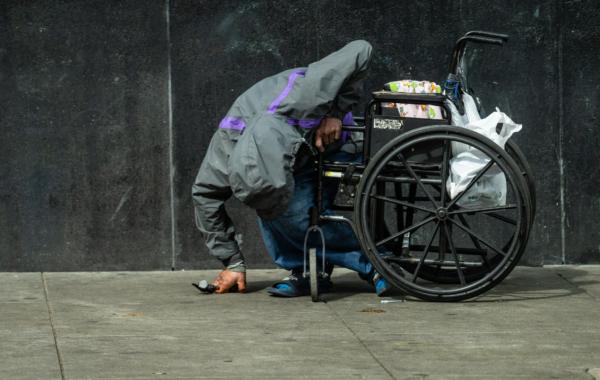
A homeless man sits passed out next to an empty syringe in San Francisco, on Feb. 23, 2023. (John Fredricks/The Epoch Times)
Treatment on Demand
Smith maintains a good attitude and is genuinely committed to helping people, Maldonado said.“JJ does a good job. We appreciate what he does,” he said.
He brings addicts to Harbor Light because he knows The Salvation Army won’t turn them away, Maldonado said.
It’s disheartening to see efforts to help addicts recover impeded by a bureaucratic system that is supposed to provide treatment on demand, he said.
“They put you through a process that is onerous for us, let alone for a client in the street ... and it makes it hard for the people who are out there to get drug treatment,” he said.
The city funds about a third of the 96 beds in the Harbor Light residential program, Maldonado said.
In early October, about 86 beds in the residential program were full, with another 30 people in the detox program, he said.
During the 2023–2024 fiscal year, The Way Out recovery system of care, which encompasses several programs including Harbor Light, served 851 clients, according to The Salvation Army’s impact report.
Although not all participants complete the program, many do and go on to lead clean, sober, and productive lives. About 76 percent of those who completed the whole continuum of care through the final phase of the transitional housing program were successful and are now living independently. A sampling of previous graduates at six- and 12-month follow-ups showed that all of them were still sober, employed, and housed, according to the report.
“Our model works,” Maldonado said.

